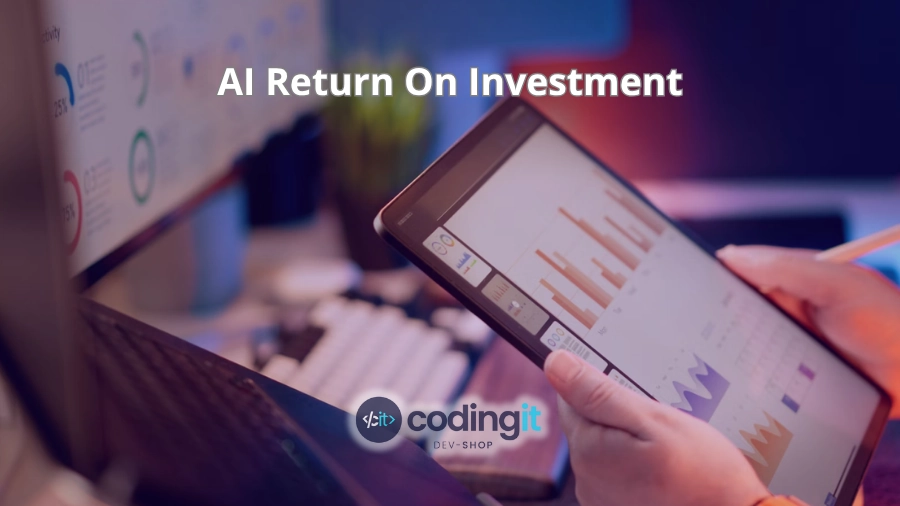Most companies measure AI in the same way they measure software upgrades. To us, that’s the wrong ROI conversation. They look for AI ROI in headcount reductions, license cost savings, or time shaved off manual tasks.
While those things might show up nicely in a spreadsheet, they say very little about whether AI is working as a strategic investment.
Most see AI as a magic tool that you plug in and wait for savings. But AI is a system-level shift. One that affects how your teams operate, how fast they learn, how decisions are made, and how your organization adapts. If you’re only measuring cost reduction, you’re missing where the real value sits. And possibly setting yourself up to fail.
This mindset (chasing the obvious wins) is comfortable, I’ll give you that. It’s easy to present to stakeholders. It produces neat before-and-after slides. But it’s also shallow. It ignores the compounding value of speed, the importance of trust in systems, and the cultural muscle required to turn AI from a prototype into actual leverage.
If the conversation doesn’t evolve, neither will the companies using AI. So, let’s work on redefining AI ROI.
Blog Summary:
AI is everywhere, but how we define its success is still stuck in old thinking. In this post, we’ll explore:
- Why most AI ROI models are built around the wrong incentives
- What companies miss when they only track visible wins
- How speed, trust, and decision quality quietly compound over time
- What signals show that AI is moving the needle
- Why structure and culture often matter more than the model itself

Table of Contents:
Short-Term Metrics, Long-Term Risks
When companies talk about AI impact, they usually start with numbers that are easy to collect and fast to show: hours saved, tasks automated, people reassigned. That’s not useless. But it’s also not enough.
The problem with chasing short-term metrics is that they create a false sense of progress. Just because something got automated doesn’t mean it got better. Just because a workflow got faster doesn’t mean the outcomes improved. And just because you saved money doesn’t mean you’re more competitive.
Worse, those shallow wins can become distractions. They let companies feel like they’re “doing AI” without making the structural or cultural changes that move the needle. So instead of evolving, they optimize the old model. They run the same playbook, just with more tools.
This is how AI ends up boxed into isolated pilots, disconnected dashboards, and automations no one trusts. All measurable. None transformative.
What Gets Measured Gets Misunderstood
The way you define AI ROI shapes how you build, deploy, and trust the system in the first place, not just how you evaluate results. When teams optimize for surface-level metrics, they also design for surface-level outcomes. That affects everything: the use cases you prioritize, the way you handle edge cases, and how much ownership your team feels over the results.
It’s subtle, but real. If the success metric is “tasks automated,” the solution will likely be rigid, narrow, and fragile under pressure. If the metric is “speed to decision,” you’ll likely build something adaptive, like a tool that evolves with your process, not outside it.
This is why AI ROI isn’t a reporting issue; it’s a strategic one. The metrics you pick signal to your team what matters. And they guide the decisions that follow: technical, operational, and cultural. If your metrics are outdated, your AI strategy will be too. Even if the tech is world-class.
The Illusion of Automation Wins
It’s no coincidence that automation gets so much attention when we talk about AI ROI. It’s visible, easy to quantify, and makes for a good slide in a quarterly update. But that visibility can be misleading.
Automating a task might reduce the time it takes to complete it, but it doesn’t necessarily make the task more valuable. And it definitely doesn’t mean the surrounding process got better. In fact, locking in a flawed process through automation can make it harder to fix later.
We’ve written about how metrics that look good on dashboards can create a false sense of progress before. We called them vanity metrics. Automation falls into that category when it’s measured in isolation.
Companies overvalue automation because it’s easy to explain. And that’s the trap. In doing so, they undervalue what drives sustainable ROI: clarity, speed, and adaptability. AI has the potential to impact all three. Only if you stop treating automation as the end goal.
Speed: The Undervalued Advantage
Speed doesn’t show up on most AI ROI dashboards. And yet, it’s often the clearest sign that the system is doing its job.
We are not talking about how fast the model runs. We mean how quickly your team can ask better questions, test assumptions, and move on to the next iteration. AI that saves time but slows down thinking isn’t helping. AI that shortens the path from insight to action? That’s leverage.
Speed compounds. It helps you learn faster, not just help you make decisions faster. That’s where the competitive advantage is. Because the teams that move faster adapt quicker. They correct earlier. They gain clarity while others are still framing the problem.
That’s not something you’ll see on a chart next to cost savings or hours automated. But it’s often the difference between teams that scale AI and teams that quietly shelve it.

Decision Quality
Most teams still measure AI ROI by what it produces: summaries, forecasts, recommendations, answers. You know what matters equally if not more? What do those outputs lead to?
Outputs are easy to generate. Good decisions are not. If an AI tool gives you information but no one uses it (or worse, they follow it blindly without understanding), the real value never lands. You’re just increasing noise. What you want is lift: sharper judgment, clearer priorities, more confidence in action.
That’s harder to measure, but it’s not invisible. Look at the quality of decisions over time. Look at how fast people move from data to action. Look at how much better your bets get. Because AI doesn’t pay off when it spits out answers. It pays off when those answers lead to smarter moves.
Cultural Readiness is ROI
Most failed AI initiatives don’t fail because of the model. They fail because no one knew what to do with it once it worked. You can’t drop AI into a team that avoids experimentation, fears being wrong, or waits for permission to act and then expect it to create value.
The system might run, but the organization around it stalls. Culture influences more than adoption; it determines whether adoption even happens. If your teams don’t question results, don’t improve them, and don’t own them, there’s no real AI ROI. At best, you’ll get outputs that look fine on paper but never make it into decisions.
Cultural readiness means people know how to work with AI. It means they’re trained to interpret, challenge, and build on what the system delivers. That’s where the actual return happens, not in the model, but in how people use it to operate differently.
And none of that works without trust. If your team is second-guessing every output or quietly working around the system, you won’t see adoption. And without adoption, there’s no return. It’s that simple.
Is Your Org Chart the Problem?
Some initiatives don’t fail because of the tech or the team. They fail because no one knows who owns the outcome. In fact, in many organizations, AI lives in a corner. Under innovation, or IT, or “experiments.” That setup might work for testing, but not for impact. Because real AI ROI comes from integration with ownership.
When AI runs into silos, decision bottlenecks, or teams that don’t talk to each other, its value stalls. You might get a great model, but it won’t change how work gets done. Not because it can’t, but because no one was empowered to make that happen.
The bigger the company, the more likely it is that AI ends up trapped in a loop of approvals, unclear handoffs, and orphaned tools. Even the most promising initiative can quietly lose momentum if the structure isn’t built to support change across teams.
It’s an org design problem. If the people responsible for AI outcomes don’t sit close to the decisions, the execution will always lag behind the intent. If your structure wasn’t built to support change, AI won’t change much.
The New Metrics
Let’s focus on what’s more useful to ask when talking about AI ROI.
- Decision speed: Not model latency, but organizational latency. How long does it take for your team to move from a question to a confident next step? Are blockers being removed, or just better reported?
- Clarity under pressure: Does AI reduce ambiguity when the stakes are high? Are decisions becoming more repeatable, or still dependent on a few experienced voices?
- Alignment: When two teams look at the same output, do they reach the same conclusion? Or spend hours debating what it means? High AI ROI shows up in shared context and fewer misreads.
- Trust and adoption: Are people relying on the system because it makes them better at their job? Or because they were told to use it? The difference matters.
- Learning cycles: Are your teams iterating faster? Is feedback from the ground reaching the system and shaping how it works? AI that improves but doesn’t adapt isn’t improving enough.
These aren’t the kind of metrics that fit neatly into a dashboard. But they tell you whether AI is doing what it should: expanding your team’s capacity to think clearly, act faster, and operate with more confidence under uncertainty.
What Success Looks Like
Real AI ROI doesn’t always look impressive at first glance. Sometimes it’s subtle. A team that asks better questions. A decision that gets made two days earlier. A problem that surfaces before it spreads.
While these moments don’t always show up in reports, they accumulate. And over time, they separate the companies that build lasting systems from the ones that just chase hype.
If you are waiting for AI to do everything, you might find yourself waiting for a long time. The true advantage of AI is making your people faster, sharper, and more confident in the face of complexity.
That’s what we focus on at CodingIT. We help companies design and deploy AI initiatives that surpass basic technical functionality and resonate with people, teams, and decisions. If your organization is serious about defining AI ROI beyond the obvious, let’s talk.
